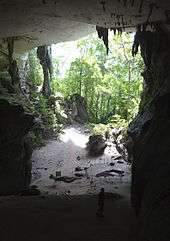Niah National Park
| Niah Caves | |
|---|---|
|
The main entrance to the Niah Caves at sunset. | |
| Coordinates | 3°48′50″N 113°46′53″E / 3.81389°N 113.78139°ECoordinates: 3°48′50″N 113°46′53″E / 3.81389°N 113.78139°E |
| Discovery | 1950 |
| Entrances | 1 |


Niah National Park, located within Miri Division, Sarawak, Malaysia, is the site of the Niah Caves, a limestone cave and archeological site. Niah National Park was 31.4 km² when it was gazetted in 1974.[1] Nomination for World Heritage status of the Niah Caves was sent to UNESCO in 2010.
Niah Caves
The main cave, Niah Great Cave, is located in Gunung Subis and is made up of several voluminous chambers with high ceilings. The Great Cave lies in a large limestone block, about a kilometre long in general north to south direction and about half a kilometre wide, that is detached from the main Gunung Subis complex, by a valley between about 150 to 200 meters wide. The main Gunung Subis complex rises to about 394[2] meters above sea level at its highest point. The whole "Gunung Subis Limestone Complex" lies some 17 kilometres inland from the South China Sea coast and about 65 kilometres south west of the town Miri. It is roughly heart shaped measuring five kilometres from its northern tip to the south and four kilometres across. The Gunung Subis is surrounded by a low countryside with gentle hills from which the small limestone massiv and its smaller detached blocks rise rather abruptly out of the jungle, some with cliffs over 100 metres high.[3] Though it is not an extensive cave system compared to others in Sarawak, it has been estimated to cover some 10 hectares and the roof rises to about 75 metres above the cave floor in some places.[4] In geological terms, the limestones are part of the Subis Formation. This is dated to some 20 to 16 million years ago during the Early Miocene.[3]
Archaeology
The caves have been used by humans at different times ranging from the prehistory to neolithic, Chinese Sung-Era and more recent times.The Sarawak Museum began systematic archaeological work in the caves since 1954.
The cave is an important prehistorical site where human remains dating to 40,000 years have been found.[4] This is the oldest recorded human settlement in east Malaysia. More recent studies published in 2006 have shown evidence of the first human activity at the Niah caves from ca. 46,000 to ca. 34,000 years ago.[5] Painted Cave, situated in a much smaller limestone block of its own, some 150 metres from the Great Cave block's south eastern tip, has rock paintings dated as 1,200 years old. Archeologists have claimed a much earlier date for stone tools found in the Mansuli valley, near Lahad Datu in Sabah, but precise dating analysis has not yet been published.[6]
Research was pioneered by Tom Harrisson in the 1950/60s.[7] Since then local universities and foreign scientists have continued the archaeological research, and many articles have been published in the Sarawak Museum Journal. The site has been re-excavated (1999–2003+)[8] by a joint British-Malaysian expedition to determine the accuracy of Harrisson's work.
Items found at Niah Cave include Pleistocene chopping tools and flakes, Neolithic axes, adzes, pottery, shell jewellery, boats, mats, then iron tools and ceramics and glass beads dating to the Iron Age. The most famous find is the human skull dated at around 38,000 years BCE.[4][8] Painted Cave has paintings and wooden coffin 'death ships'.
Current activities
The caves are also well known for the birds' nest (Swiftlet) industry. They are a popular tourist destination in Sarawak. Every section of the ceiling in the caves where there are birds roosting is privately owned and only the owner has the right to collect the nests. Collection is done half-yearly (usually in January and in June). The collector climbs up hundreds of feet on a single pole to the cave ceiling and scrapes off the nest in flickering candlelight.
See also
References
- ↑ Niah National Park from Sarawak Forestry
- ↑ Niah National Park at Geographia.
- 1 2 Short description for a cd-rom about the caves by Ecomedia Software
- 1 2 3 "The Great Cave of Niah" by Huw Barton
- ↑ Barker, Graeme; et al. (2007). "The 'human revolution' in lowland tropical Southeast Asia: the antiquity and behavior of anatomically modern humans at Niah Cave (Sarawak, Borneo)". Journal of Human Evolution (Elsevier) 52 (3): 243–261. doi:10.1016/j.jhevol.2006.08.011. PMID 17161859. Retrieved 7 April 2012.
- ↑ Fong, Durie Rainer (10 April 2012). "Archaeologists hit 'gold' at Mansuli". The Star. Retrieved 15 April 2012.
- ↑ Harrisson, Tom (1957). "The Great Cave of Niah: A Preliminary Report on Bornean Prehistory". Man 57: 161–166.
- 1 2 The Niah Cave Project at the University of Leicester.
Further reading
External links
| Wikimedia Commons has media related to Niah Caves. |
- Tourism Malaysia - Niah National Park
- A short description of the caves as a touristic destination.
- Summary of the article "A short history of birds' nests management in the Niah caves (Sarawak)." by Quentin Gausset from the "Borneo Research Bulletin" published in 2002.
- Another version from the Sarawak Forestry with a map of the caves
- Article with a picture of some paintings and death ships.
- Picture of some cave paintings.
| ||||||||||||||||||||||
| ||||||||||
